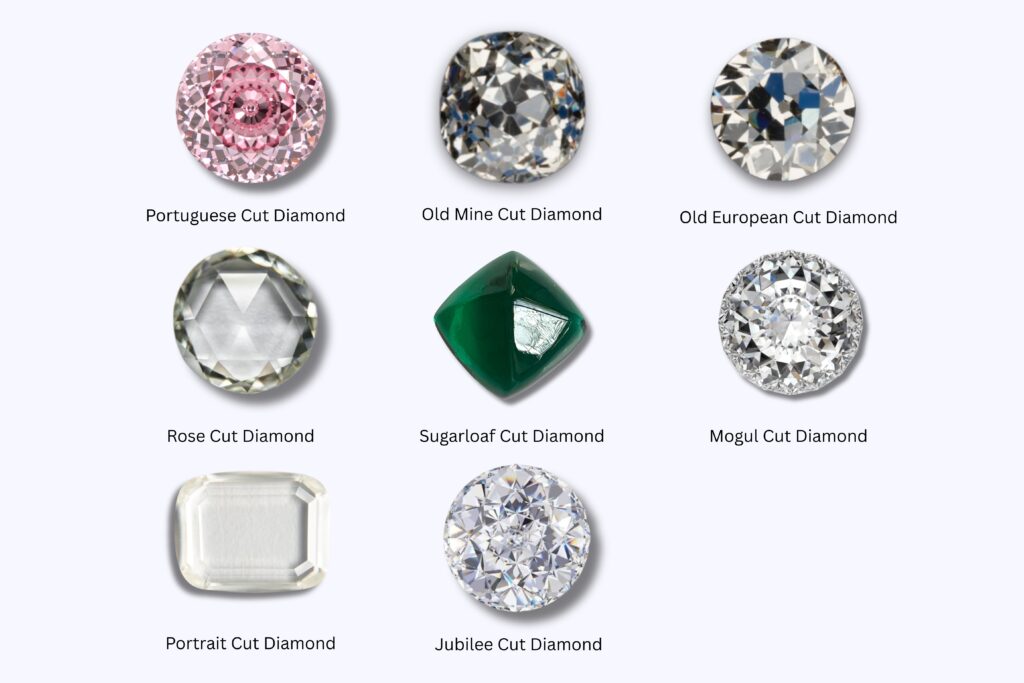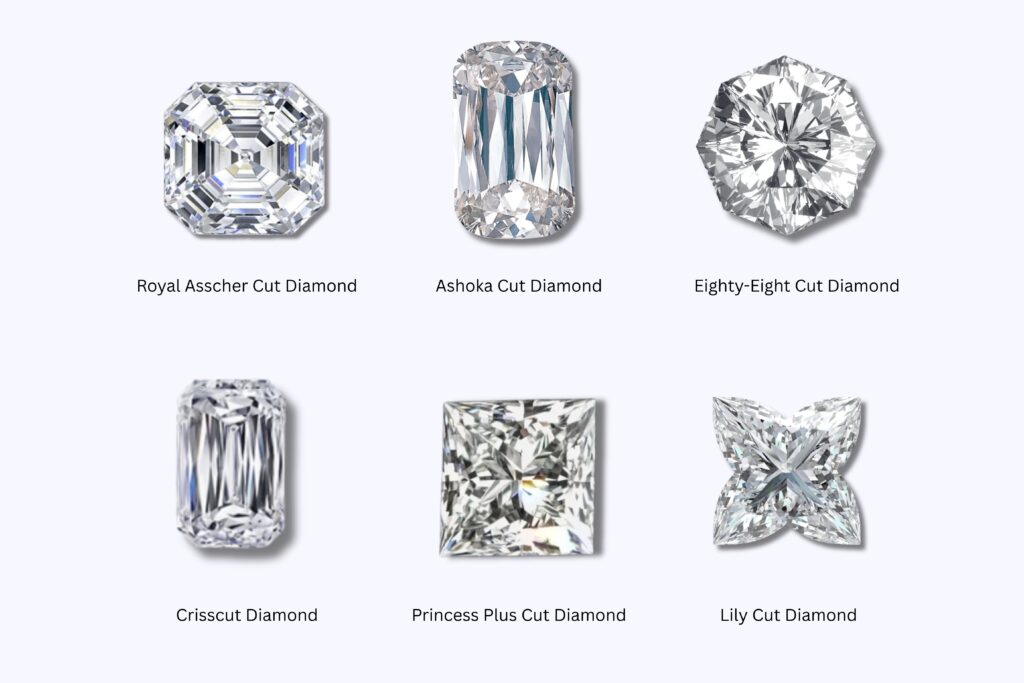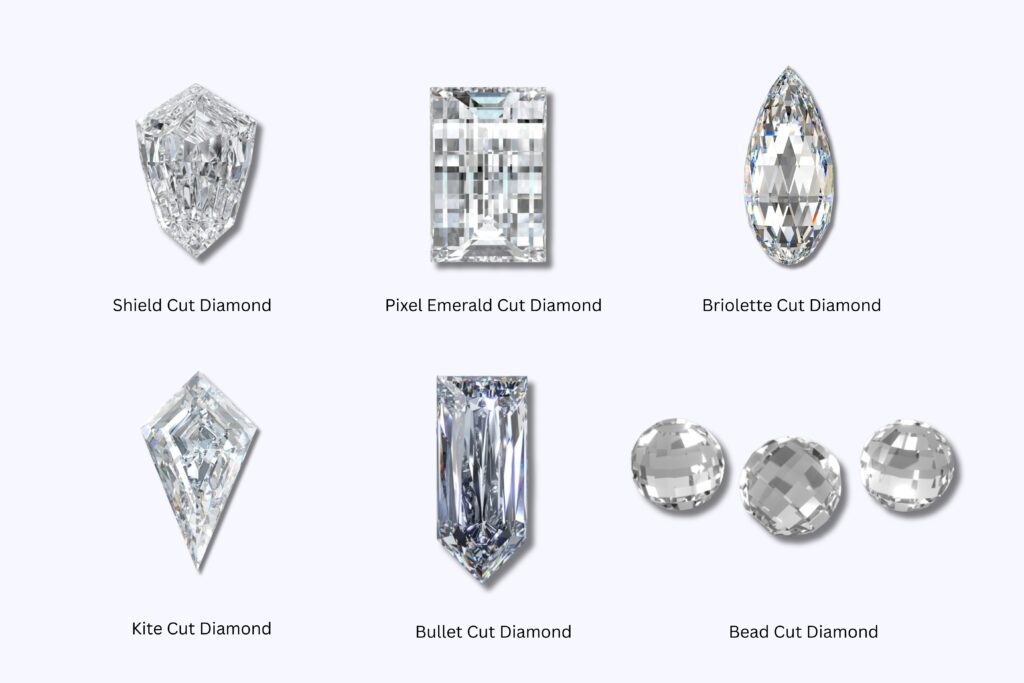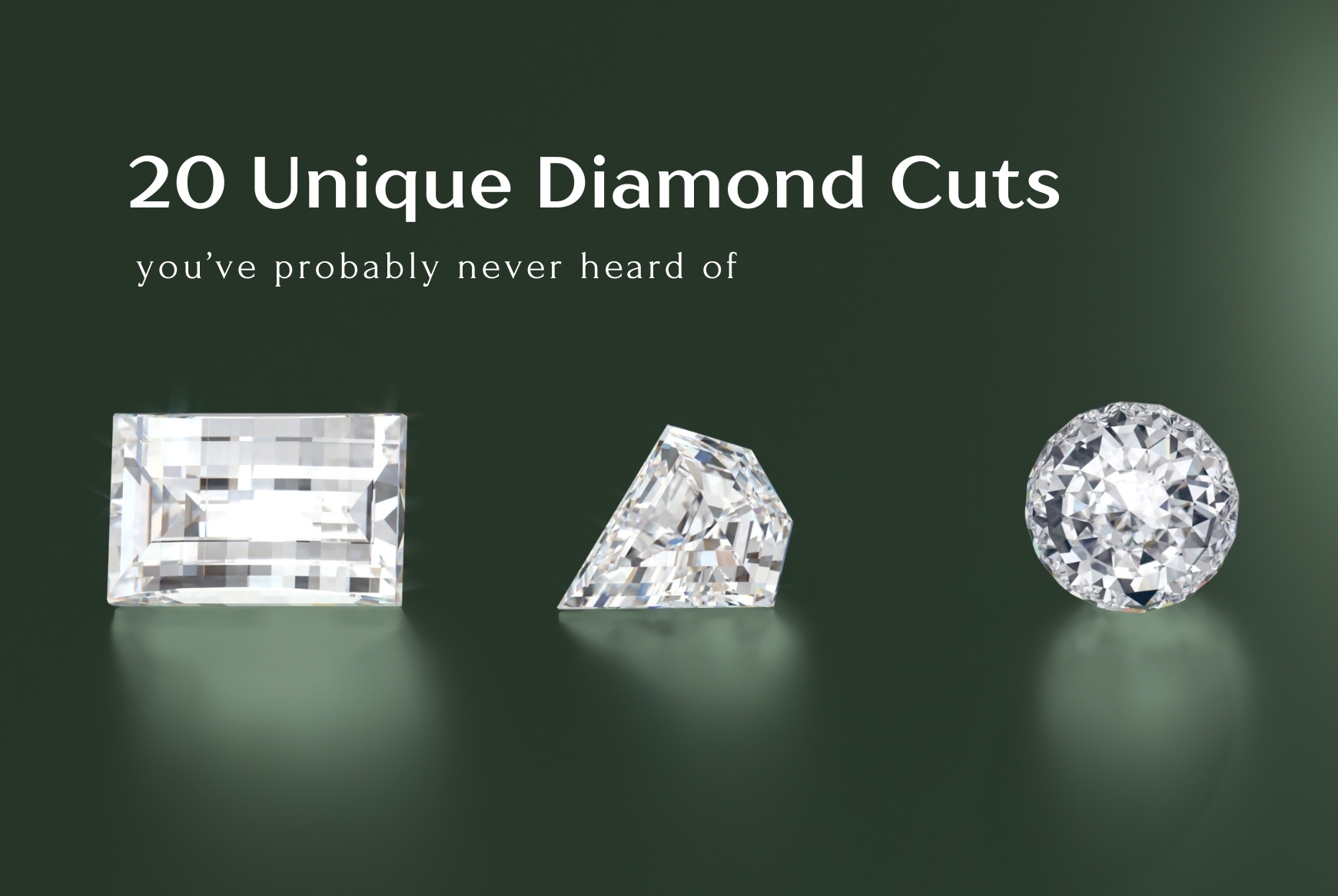20 Unique Diamond Cuts You’ve Probably Never Heard Of
When you think of a diamond, a specific image probably comes to mind: a brilliant, sparkling round stone. But beyond that familiar image lies a fascinating world of unique diamond cuts. In this article, we’re going to walk through 20 rare and unique diamond cuts that don’t often make it to mainstream jewelry counters.
You’ll learn how certain antique cuts were shaped by hand centuries ago, which modern patented cuts have redefined brilliance, and how technology today makes it possible to create custom shapes in lab-grown diamonds. We’ll also look at the stories, history, and artistry behind these unconventional designs, and why they continue to captivate collectors, jewelers, and anyone who wants their jewelry to stand out.
What are Unique Diamond Cuts?
A unique diamond cut isn’t the kind of stone you’ll see in every jewelry shop window. These are the diamonds that feel different, whether it’s because of their unusual shape, the way their facets catch the light, or the history they carry.
They’re the kind of gems made for people who don’t just want sparkle, but a story. In the past, many of these rare cuts were handcrafted, often for royalty or collectors, which is why surviving pieces are highly valued today. But times have changed. With today’s technology, cutters can shape lab-grown diamonds into almost anything you can imagine. From reviving forgotten antique cuts to creating entirely new designs, custom cutting is no longer just for the elite; it’s now within reach for anyone who wants their diamond to be as individual as they are.
From Antique to Avant-Garde: These are the Rarest & Unique Diamond Cuts
You’ve seen the classic brilliant cut, but what about the rest of the family? Every diamond cut has its own unique personality, born from a blend of history, technology, and pure artistry. Think less “gemstone” and more “character.” From the romantic glow of a stone cut by hand to the breathtaking precision of a modern masterpiece, these cuts tell a story all their own.
Here’s a look at some of the most fascinating diamond cuts, the ones you won’t see every day, each with a history that makes it more than just a piece of jewelry.
Antique & Vintage Cuts:-

These cuts were born in a different era, often shaped by hand without the aid of modern technology. They offer a warmth and character that modern cuts lack, making them treasured artifacts of jewelry history.
Portuguese Cut Diamond
The Portuguese cut is a dazzling throwback to old-world craftsmanship. With its unusually high number of facets (sometimes more than 160), it creates a kaleidoscope of light within the stone. The small table and tall crown give it a deep, mirror-like brilliance that feels less like sparkle and more like liquid light. Because it requires so much rough diamond to achieve, it’s incredibly rare today, a true treasure for collectors who seek unique antique diamond cuts with soul.
Old Mine Cut Diamond
Think of grand ballrooms lit by candlelight, that’s where the Old Mine cut shines. Born in the 18th and 19th centuries, this cushion-shaped diamond, characterized by a high crown, deep pavilion, and open culet, was crafted entirely by hand. Its chunky facets and soft glow were designed for gaslight and candlelight, not spotlights. Each stone feels a little imperfect, a little asymmetrical, but that’s exactly what makes it romantic. Owning one means holding a genuine piece of history.
Old European Cut Diamond
If the Old Mine was the ancestor, the Old European is the great-grandfather of today’s round brilliant. Popular in the late 19th to early 20th century, this cut features a rounder outline with a small table, high crown, and visible culet. Its broad, chunky facets flash with dramatic contrast, creating a moody, almost vintage fire. Collectors love the Old European because it bridges eras, antique in character but closer to the modern sparkle we know today.
Rose Cut Diamond
First appearing in the 16th century, the Rose cut is instantly recognizable for its flat bottom and domed top, covered in triangular facets. It doesn’t glitter like a brilliant cut — instead, it glows softly, like moonlight on water. This subtle shimmer has made it a favorite for designers who love understated, vintage-inspired jewelry. If you’re looking for a rare diamond cut that whispers rather than shouts, the Rose cut is timeless.
Sugarloaf Cut Diamond
Before sugar came in packets, it was sold in tall, cone-shaped loaves. Jewelers borrowed that everyday image for this cut, a domed, step-cut diamond that looks more like a sculpture than a sparkle machine. The Sugarloaf cut is a rare step-cut with a unique, pointed top. You’ll often find these cuts in Art Deco pieces, where their geometric, architectural lines fit right into the period’s love for sharp, clean design.
Mogul Cut Diamond
Mogul cut diamond, also known as Mughal, is one of the most ancient diamond cuts, born from a time when the goal was to keep as much of the original rough stone as possible. It’s an altered rose cut, often appearing like a thick, domed, and almost egg-shaped gem with random facets. The most famous example is the legendary Koh-i-Noor, which was cut in the Mughal style. This cut is more about the raw, natural beauty of the stone than its fiery brilliance, and holding one is like holding a piece of forgotten history.
Portrait Cut Diamond
The Portrait cut is not about fire at all; it’s about transparency. Originating in India, this ultra-thin, flat diamond slice was used as a “window” over miniature portraits or mementos. Its large open table and minimal facets demand exceptional clarity, since there’s nowhere to hide flaws. Often bezel-set for protection, a Portrait cut diamond feels like a piece of jewelry and art history merged, elegant, discreet, and deeply personal.
Jubilee Cut Diamond
Created in 1887 to celebrate Queen Victoria’s Golden Jubilee, the Jubilee cut is a cushion-shaped diamond with extra facets to boost brilliance. It combines the charm of antique shapes with sparkle that rivals modern cuts. Because of its commemorative origins, it’s incredibly rare and meaningful, appealing to collectors of historic diamond cuts.
Modern & Patented Cuts:-

These contemporary designs push the boundaries of diamond cutting, often protected by patents or trademarks to ensure their exclusivity and unique sparkle.
Royal Asscher Cut Diamond
The Royal Asscher Cut is the modern evolution of the original Asscher cut, first created in 1902 by the Asscher family of Holland, the world’s very first patented diamond cut. While the original had 58 facets, the Royal Asscher, patented in 2002, was reimagined with 74 carefully aligned facets that enhance its symmetry, depth, and sparkle. Its design of concentric squares with cropped corners creates the famous “hall of mirrors” effect, a mesmerizing play of light that feels geometric and hypnotic. Though the original patent has long expired, the Royal Asscher Cut continues to embody timeless Art Deco elegance with a modern brilliance.
Ashoka Cut Diamond
The Ashoka Cut Diamond, named after the legendary Indian emperor, is one of the rarest patented designs in the world. Only a select few rough stones can be crafted into this elongated cushion cut, which features a high crown and 62 facets. Its elongated rectangular shape gives it an impressive optical advantage, often appearing up to 30% larger than an emerald cut of the same carat weight. Known for its fiery brilliance, the Ashoka Cut is as much a rarity as it is a statement, often gracing the fingers of Hollywood icons and collectors who appreciate its exclusivity.
Eighty-Eight Cut Diamond
In many Asian cultures, the number eight is a symbol of good fortune. This patented design carries 88 facets, each cut for maximum light play. The result? A diamond that flickers like a kaleidoscope, a captivating sight. The cut is often found in unique engagement rings and is sought after for its symbolic meaning as much as its stunning brilliance.
Crisscut Diamond
At first glance, the Crisscut® Diamond may look like a traditional emerald cut, but one look closer and you’ll see why it stands apart. Developed and patented by Christopher Designs in 1998, the Crisscut® features 77 triangular and trapezoidal facets arranged in a unique crisscross pattern. This innovative faceting dramatically enhances brilliance and fire, giving the stone a kaleidoscopic effect that step cuts can’t match. It’s the perfect blend of elegance and innovation, making it a favorite for those who love a modern twist on tradition.
Princess Plus Cut Diamond
The Princess cut is a popular choice for its modern, clean lines and brilliant sparkle. But a Princess Plus is a step up. This patented cut adds 40 more facets to the traditional Princess, bringing the total to 101. The result is a diamond with even more surface area and a breathtaking brilliance that seems to draw light from every direction. It’s a modern twist on a classic, perfect for someone who loves the princess cut but wants something truly special.
Lily Cut Diamond
The Lily Cut Diamond is a true work of art, created by Lili Diamonds and famously exclusive to Louis Vuitton jewelry, according to Natural Diamonds. As its name suggests, it takes inspiration from a lily flower, with four delicate petal-like points formed by its 77 carefully polished facets. This patented cut is as romantic as it is innovative, reserved for the most luxurious collections. With its flowing curves and radiant sparkle, the Lily Cut is the ultimate symbol of modern elegance paired with nature-inspired beauty.
Artistic & Unconventional Cuts:-

These cuts are less about conforming to a standard and more about creating a unique visual effect.
Shield Cut Diamond
As the name suggests, this diamond is shaped like a shield, with a wide top and a pointed bottom. Its shape is often used as a side stone to flank a larger center diamond, but it can also hold its own as a center stone for a modern, bold ring. The design is a powerful statement, often used to symbolize protection or strength.
Pixel Emerald Cut Diamond
A truly modern design, the Pixel cut is a geometric marvel. It features a mosaic of tiny, rectangular, and square facets arranged to create a pixelated effect. This patented cut looks like a digital work of art, with light dancing across its surface in a futuristic, fragmented sparkle. It is the perfect choice for a minimalist yet striking piece.
Briolette Cut Diamond
A vintage cut that feels modern, the Briolette is a three-dimensional drop shape, a full teardrop, not a half. It has no girdle or table; instead, it is faceted all around its surface, making it look like a shimmering, spinning raindrop. Because there are no flat surfaces to set, it is often drilled through and suspended, allowing it to move freely and catch the light from every angle.
Kite Cut Diamond
This diamond shape has four sides, with two long and two short, meeting at a point at the top and bottom, creating a geometric kite shape. It’s often used as an accent stone or in a pave setting to create a shield-like effect. As a center stone, its clean, angular lines make it a favorite for those who want a minimalist, contemporary feel.
Bullet Cut Diamond
Resembling the sleek, elongated shape of an unshot bullet, this diamond is a slim, elegant cut with a pointed end. It’s rarely used as a center stone but is prized for its ability to act as a side stone, creating a smooth transition from a central gem to the band. With its clean lines, it works beautifully with emerald cuts or other step-cut diamonds.
Bead Cut Diamond
This is more of a shape than a traditional cut, as it is faceted on all sides and often drilled through to be used in strands for necklaces and bracelets. Diamond beads, often seen in a variety of colors from black to champagne, are a departure from traditional jewelry. The diamond’s facets create a subtle, all-over shimmer rather than a single focal point, perfect for a bohemian or high-fashion look.
What Makes These Diamond Cuts So Unique?
| Diamond Cut | Origin / History | Why It’s Unique |
|---|---|---|
| Rose Cut | Born in 16th-century Europe during the Renaissance | Designed for candlelit evenings; soft, romantic glow instead of sharp sparkle; beloved in Georgian & Victorian jewelry. |
| Mogul Cut | Crafted by Indian artisans in the Mughal courts (16th–19th century) | Thick, domed style preserved carat weight; many set into ceremonial jewels and swords; prized by emperors for grandeur. |
| Old Mine Cut | 18th–19th century Brazil and India diamond mines | Predecessor of cushion cut; hand-crafted with chunky facets; reflects the artistry of cutters before precision machines. |
| Old European Cut | Bridge between candlelight romance and modern sparkle; a rounder outline created dramatic flashes of light. | Inspired by cone-shaped sugar loaves, often found in sapphires/emeralds, admired for their architectural, sculptural look. |
| Portuguese Cut | Linked to 18th-century Portugal; revived in Art Deco jewelry | Up to 160 facets; sacrificed much rough, making it rare; known for “liquid light” brilliance reserved for wealthy patrons. |
| Portrait Cut | Originated in India, 1600s | Flat diamond slices used as “windows” over miniature paintings or mementos; prized for clarity and storytelling, not fire. |
| Sugarloaf Cut | Used in Mughal and later Art Deco pieces | Reinvented emerald cut with 77 facets in a crisscross pattern; gives step-cut stones more life and fire. |
| Jubilee Cut | Created in 1897 for Queen Victoria’s Diamond Jubilee | Cushion shape with extra facets; symbol of prestige and celebration; extremely rare since never mass-produced. |
| Royal Asscher Cut | Patented in 1902 by Asscher brothers, Amsterdam | Famous for “hall of mirrors” depth; became iconic after cutting the Cullinan diamond; hallmark of European cutting. |
| Ashoka Cut | Inspired by an ancient 41.37 ct diamond of Emperor Ashoka (India) | Revived as a patented cut; elongated cushion shape appears up to 30% larger; blends heritage with modern brilliance. |
| Eighty-Eight Cut | Modern patented design influenced by Asian numerology | 88 facets + octagonal shape; number 8 symbolizes prosperity and luck; merges brilliance with cultural symbolism. |
| Crisscut | Faceting mimics pixelated digital art; it appeals to tech-inspired, futuristic jewelry lovers. | Modern branded variation of the Princess cut |
| Princess Plus Cut | Patented in the 1990s by Christopher Slowinski | Adds 40 extra facets (total 101); created for maximum brilliance; popular in bridal jewelry. |
| Lily Cut | Modern patented design, early 2000s | Shaped like a lily flower with 77 facets, it is marketed for romance and luxury bridal collections. |
| Shield Cut | Contemporary adaptation of heraldic shields | Symbolizes strength and protection; used in bespoke designs and bold modern rings. |
| Pixel Emerald Cut | 21st-century innovation | In the late 1800s, with the rise of electricity |
| Briolette Cut | Among the oldest cuts, popularized in the 14th century Europe | Fully faceted teardrop shape; worn as pendants by queens (Marie Antoinette loved them); designed to sparkle while moving. |
| Kite Cut | Modern geometric cut | Four-sided diamond resembling a kite; favored by avant-garde designers; adds angular flair in contemporary settings. |
| Bullet Cut | Among the oldest cuts, popularized in the 14th century in Europe | Sleek, elongated bullet shape; often paired with emerald cuts; reflects modernist architecture of the era. |
| Bead Cut | Antique Indian & Middle Eastern jewelry | Originated in the Art Deco era (20th century) |
Why Most People Only Know a Few Diamond Cuts?
- Mass Production and the Magic of Sparkle
The most popular cuts, like the round brilliant cut diamonds, became so beloved because they’re a marvel of efficiency. Diamond cutters designed them to get the most sparkle and weight out of a typical rough stone, which means less waste. This efficiency makes them more accessible and appealing to the masses. These diamonds can be produced on a large scale, making them the most readily available and a natural first choice for many. Unique cuts, on the other hand, often require a specific rough diamond shape or more highly skilled, time-consuming hand-crafting.
- People follow what’s familiar and socially validated
For nearly a century, advertising has shaped our idea of the perfect diamond. Slogans like “A Diamond is Forever” were almost always paired with a classic round solitaire, cementing its place in our hearts. This media influence creates a powerful association between that specific cut and a timeless symbol of love. When we see classic cuts everywhere, on celebrities, in movies, and on our friends, they feel like the “right” choice. It’s a comfortable, socially validated path that makes a significant purchase feel less risky. Stepping into the world of unique cuts requires a little more confidence and a desire to forge your own path.
FAQs
Are there any new or unusual diamond cuts recently introduced by designers?
Yes, there are many new and exciting designer innovations. Cuts like the floral-shaped Lily cut, the ultra-brilliant Princess Plus cut, and the exclusive Asprey cut are recent examples of unique diamond cuts created to offer a distinctive look for a modern engagement ring or piece of jewelry.
Can a custom jeweler create any unique diamond cut I want?
A skilled custom jeweler can create many unique diamond shapes and even design a new cut for your engagement ring. However, they cannot replicate patented designs like the Ashoka or Lily cut, which are exclusive to their creators. For a truly rare diamond cut, working with a specialist is key.

